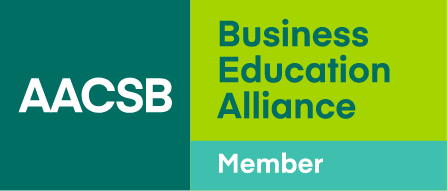Top 3 Higher Education Trends to Watch in 2025
Sponsored Content
- In response to concerns over the real-world ROI of higher education, educators must adopt career-aligned curricula, offer accelerated degrees, and tailor microcredentials to evolving labor market needs.
- As prospective students cite finances and application confusion as barriers to business education, schools can expand their outreach, leverage partnerships, and make their programs more accessible and affordable.
- In a crowded global market for business education, branding has become a critical differentiator, with academic leaders increasingly relying on data analytics to sharpen their messaging.
Higher education institutions will continue to experience waves of turbulence and uncertainty in 2025—and business schools are no exception. With the world’s economy and job markets in flux, it’s no surprise that academic leaders across the globe are working to modernize their offerings and strengthen their competitive outlook.
To help college and university administrators keep pace with evolving student and employer needs, Hanover Research has released its 2025 Trends in Higher Education report, which highlights emerging practices and targeted guidance that academic leaders can apply to navigate the year ahead.
If you are a business school leader, 2025 is a critical year for you to embrace data-informed trends, align academic programs with workforce demands, expand innovative enrollment tactics, and leverage branding to differentiate your offerings. Below are three trends that promise to have the greatest impact on business education this year—along with best practices and tips you can use to future-proof your strategies and operations.
Trend No. 1: Demand for Career-Aligned Programs
The demand for skill-based learning in higher education is nothing new. However, students in the latest generation are expressing greater concern over higher education’s return on investment (ROI). Students and families who want to make the most of their educational investments will likely view career-aligned academic programs as essential to a graduate’s future success.
Many colleges and universities have already taken steps to improve their strategies for keeping their curricula in line with workforce trends. In fact, according to a 2024 survey of chief academic officers, 14 percent of provosts report that their institutions have reviewed the curriculum to ensure it will prepare students for the rise of generative artificial intelligence (AI) in the workplace. Other schools have turned to accelerated degrees, such as one-year MBA options, and microcredentials to help students get the most out of their education.
Ultimately, as public expectations about the value and purpose of a college degree change, postsecondary students across all disciplines are seeking educational opportunities with real-world applicability and a clear ROI. Simultaneously, employers are showing greater interest in upskilling their workers for a new era.
Postsecondary students are seeking educational opportunities with real-world applicability and a clear ROI, while employers are showing greater interest in upskilling their workers for a new era.
As a business school leader, how can you effectively manage and weigh these two evolving factors? To deliver improved academic programming that aligns with both student and labor market demands, you must leverage timely, data-driven practices that proactively ensure student success postgraduation. Further, to measure the pulse of vital global market trends, you must pay careful and continuous attention to labor data and prospective student concerns.
Consider the following best practices for aligning your business programs with shifting market needs:
Leverage real-time labor market data. Use resources such as economic forecasts pertaining to job postings across a range of industries to ensure your curricula reflect current expectations regarding job-related skills and experiences.
Develop a strategic framework for any microcredential offerings. Such a framework should include plans for collecting data, consulting with employers, and building stakeholder buy-in.
Identify courses for targeted audiences. Such courses should focus on helping students develop specific skills in six months or less and ideally stack toward a for-credit credential.
Ensure accelerated degree programs promote student success by providing clear scheduling policies, specialized advising, and robust academic support.
Trend No. 2: The Need to Improve Access and Affordability
While higher education enrollment in most countries has experienced modest improvements since the COVID-19 pandemic, persistent factors regarding college access threaten student yields. For example, nearly 30 percent of prospective college students in the U.S. report feeling “not at all familiar” or only “slightly familiar” with the application process, signaling that they may not understand how to apply for or finance their college education.
Additionally, the number of Americans under the age of 65 with “some college, no credential” has climbed to 36.8 million, a 2.9 percent increase since 2021. This further highlights the need to reach student populations that are outside traditional markets, including working adults and transfer students. In 2025, many institutions are reducing enrollment barriers through specialized messaging, high-touch outreach, and dedicated admissions advising support.
Limited access is not the only factor threatening enrollment growth, however. Financial viability remains another prime concern for prospective business students. Seventy-three percent of prospects for full-time MBA programs cite a lack of affordability as the main reason they choose not to apply. And with popular publications offering side-by-side comparisons of the cost to attend different international business schools, cost-conscious students across the world may consider leaving their home countries to attain more affordable business degrees.
Such gaps present valuable opportunities for business schools to gain a competitive edge by making their offerings more cost-effective. For instance, they might expand their financial aid options to include more scholarships and increase funding support through employer partnerships.
Seventy-three percent of prospects for full-time MBA programs cite a lack of affordability as the main reason they choose not to apply.
Overcoming challenges in student access and aid is not a one-size-fits-all endeavor, and success strategies will almost certainly vary across different national economies. For this reason, business education leaders everywhere must continually collect and analyze institutional data to spot enrollment challenges in their own markets and address disparities or patterns with innovative solutions.
Weigh the following tips to improve your enrollment tactics and broaden your prospective student base:
Strengthen employer and community partnerships. Seek out strategic partnerships that will expand financial aid opportunities in the form of grants, scholarships, paid internships, and other similar opportunities.
Analyze non-matriculant enrollment data to learn which student groups are not enrolling in your programs—and where they go instead. In this way, you can pinpoint opportunities to improve recruitment and onboarding efforts.
Utilize AI tools to extend institutional capacity. AI offers opportunities for you to automate and personalize recruitment-related student communications, conduct data analysis, and streamline application processes.
Trend No. 3: The Rising Importance of Branding
As higher education institutions intensify their academic and enrollment strategies to attract students, administrators may find it increasingly challenging to stand out from peers. Accordingly, campus leaders should future-proof their marketing strategies to remain competitive in a changing applicant pool.
For instance, according to Hanover's 2025 trends report, 28 percent of institutions are incorporating competitor analysis into their social media strategies in an effort to increase their brand recognition, inspire confidence, and communicate their value. In addition, as technology makes it easier for students to attend programs outside their home regions, schools are being compelled to expand their recruitment markets.
Ultimately, figuring out the best ways to differentiate your business school from global competitors involves examining data related to brand perception and performance. Then, you must use the insights you gain from this analysis to make strategic and measurable marketing and branding adjustments. For many campuses, modernizing their branded identities and images means playing to their individual strengths and leaning into their missions and values to find unique ways to speak to market needs.
To refresh your school’s identity in a competitive landscape, measure your brand health metrics over time to identify changes in the way the market views your school.
Consider the following data-driven branding practices to refine and refresh your school’s identity in an increasingly competitive landscape:
Conduct a brand profile analysis to understand how your competitors are positioning themselves and to assess your institution’s position in the market.
Run an internal brand identity survey to determine why students come to your campus and what they identify as your value proposition.
Develop a brand health tracking strategy. Measure your brand health metrics over time to identify changes in the way the market views your school and track progress toward goals. Use a mix of survey research, competitive benchmarking, and qualitative feedback to understand how stakeholders perceive your brand.
Leaning Into Times of Change
Given the rapid shifts in labor market needs, technology, economic conditions, legislative policies, and enrollment patterns, 2025 is a time for schools to lean into change. As the year progresses, academic administrators will continue to wrestle with these shifts in ways that require them to reassess and rethink the way they operate.
Business school leaders who embrace innovation over tradition will be primed to flourish in this era. But thriving under pressure requires a strategic and evidence-based approach to addressing long-standing challenges in higher education.
Academic leaders can use data such as the information in the 2025 Trends in Higher Education report to illuminate the best paths to follow in a complex market. They can use data-based insights to design academic programs that deliver strong ROI, build confident strategies to defy enrollment limitations, and refresh their brand messaging to reflect the indelible value their institutions have to offer.
In the end, the business schools that are responsive to change and that use data to make informed decisions will be the ones that find their way forward and experience sustained success.






